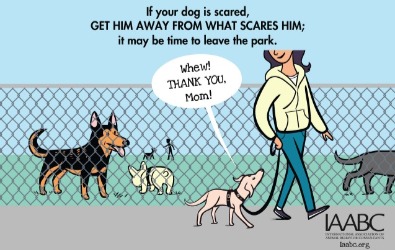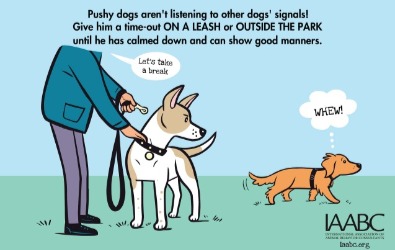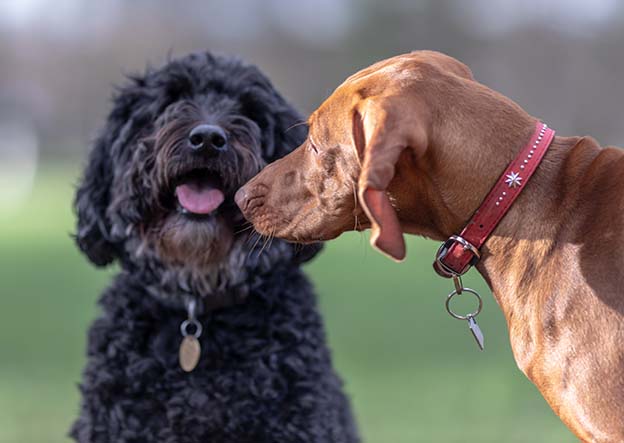Introducing Dogs to Each Other
In this post:
- Dog meeting rules
- What does a good dog meeting look like?
- What does an insecure dog meeting look like?
- How to introduce two dogs
- Why do dogs sniff butts?

Please Note: Wag Enabled content (videos, posts, and articles) should not be used to diagnose behavioral issues. The content provided in this article is meant as an educational tool. You should always work closely with your pet’s veterinarian and a professional dog trainer and/or certified animal behaviorist – especially when introducing dogs.
Although a dog will be a welcome companion into your home, dogs that have difficulty socializing and behaving with other canines can pose significant obstacles when you want to meet with friends and family who also have dogs in their homes. When two dogs meet, their first impressions matter to the extent that their first few encounters set the tone for the entirety of their relationship.
When you are introducing dogs to each other, there are certain steps that you should take to make the dogs as comfortable as possible. If they are relaxed, there is a higher likelihood that the two dogs will get along.
Before you go making new "dog friends"...
Dogs are social animals, whether they love kids, humans, or other pups, it is an important part of their lives. This is a VERY VERY DEBATED topic, these are just brief suggestions. You should always work with a trainer or a behaviorist to better understand your dog. Here are some rules though to make sure the meeting goes well:
Learn body language:
This is so important because it will allow you to better understand and interpret the situation.
The leash debate:
Many trainers believe that you should avoid having your dog meet another dog on a leash. However, this can be hard for a lot of people, especially if you live in a very dog-friendly city or apartment where you are constantly running into dogs. Follow the rules here to make those meetings safe.
3-second rule:
If you do follow through with a leash greeting, it should only be 3 SECONDS – one alligator, two alligator, three alligator – and you are out. Let the dogs walk away and “forget” each other. You can slowly increase the meeting time but you might have to go back to 3.
Don’t force things:
If you think the other dog is not interested if your dog is having a bad day, if you or the other owner is on a phone or distracted, just don’t a greeting. Don’t be afraid to say “No thank you” to a greeting.


“If your dog is scared, get him away from what scares him; it may be time to leave the park” – IAABC
Forcing a dog to stay to “get over his fears” is never a good idea. Work with a trainer or a behaviorist instead.


Pushy dogs aren’t listening to other dogs’ signals! Give him a time-out on a leash or outside the park until he has calmed down and can show good manners.” – IAABC
What Does a Good Dog Meeting Look Like?
- A good dog meeting should have all dogs relaxed. They should be able to figure each other out without feeling pressure to protect their owners. Don’t exhibit signs of nervousness or tension – they will pick up on the energy and may project it onto the other dog.
- Dogs should sniff each other’s rear ends first, and then sniff faces if they feel comfortable. Sniffing allows your dog to learn everything they need to know about the other dog including their location history, dietary habits, and whether they are in heat.
- Many dogs do not like it when a dog comes to sniff their face first, and they may correct this behavior by snarling, growling, or snapping at the rude dog. Judge whether this is correctional behavior or a sign that one dog does not like the other before making a conclusion on their relationship.
- Some dogs may stiffen up when first meeting another dog. This behavior is totally normal! As a responsible owner, you should learn what your dog is comfortable with and be able to recognize and react to their body language.
What Does an Insecure Dog Meeting Look Like?
During the meeting process, you should look out for signs that either dog is uncomfortable. An uncomfortable dog will lower its backside and will tuck its tail between its legs. A nervous dog’s ears will lay flat instead of their typical perky or raised position, and they will be looking around with big eyes for potential escape routes.
The insecure dog may bite, bark, or growl at your dog. In dog language, the dog is communicating their discomfort and your dog should back off. If your dog is the aggressor, or if the other dog is simply not comfortable with the interaction, you may have to ask your dog to come to you. This will give the insecure dog room to get meet your dog in their own terms.
How to Introduce Two Dogs
Having a trainer or animal behavioralist to help introduce two dogs can help with the introduction process. Besides recognizing signs of discomfort early, having a professional available and nearby is also mentally soothing for owners, as watching your dog interact with other animals can be stressful for owners.
The insecure dog may bite, bark, or growl at your dog. In dog language, the dog is communicating their discomfort and your dog should back off. If your dog is the aggressor, or if the other dog is simply not comfortable with the interaction, you may have to ask your dog to come to you. This will give the insecure dog room to get meet your dog in their own terms.
Do not force the two dogs to interact with each other. Take lots of time and lots of patience with it. Always start off in a neutral place with lots of rewards and praise. You want to show that the new dog is not a threat to your dog and that they can be friends.
Step One: Learn about dog body language so that you are able to identify when a dog is getting aggressive or is uncomfortable. Here are some helpful sites for that:
- Victoria Stilwell – Canine Body Language
- Stanley Coren – How To Read Dog’s Body Language
- Lili Chin – Free Dog Body Language Printouts
Step Two: Let them get to know each other slowly and carefully. Forcing two dogs to be together in a yard or in a house can lead to heartbreak and occasionally, serious injury.
Step Three: Have the dogs meet on a leash in neutral territories like a park or a neighbor’s yard or on the street up from your house. “By neutral ground, we mean somewhere none of the dogs would feel territorial and get aggressive with the other animal. The best place would be a park you have never been to.” Sarah Zayn from DiamondPup.com
- NO SNIFFING YET!!
- Take both dogs for a walk close to each other –> 10 feet or so apart.
- Do this as many times as you think is necessary for both dogs.
Step Four: Let them sniff each other FOR THREE SECONDS during the walk and still on leash.
- Three seconds is extremely important. Count it out in your head One Sniff–Two Sniff–Three Sniff and out.
- Keep walking.
- You can let them sniff each other’s butts during the walk but keep the three-second rule in the back of your head.
Step Five: Let them meet while dragging their leashes.
- Have them meet in neutral territory like a park, training center, tennis court at a park.
- Avoid areas that might make dogs feel confined –> the more room they have the better the meeting will be
- Let them sniff each other for a couple of minutes and END the session.
- If they decide to play and things are going good, let them play for a couple of minutes and then END the session.
- The reason we end the session so quickly is that we want them to end on a positive note.
Step Six: Have the dogs meet at the house.
- First!!! Pick up any toys and all food/treats to avoid fighting.
- ALWAYS meet in the yard first.
- Bring your resident dog out and your new dog into the house –> if you have your new dog come into the house with the resident dog there, you might have some territory aggression.
- Keep interactions short and pleasant.
Step Seven: Do not leave the dogs alone!! Keep them in separate rooms or in a crate.
- For about 6 months, never leave the two dogs alone unattended. This can prevent fighting while you are gone.
- This also helps your new dog to not develop any bad habits like chewing and pottying in the house.
Additional things to remember when introducing dogs from Sarah Zayn from DiamondPup.com:
Take it calmly: You found the perfect spot, and the dogs are about to meet. You might get a bit flustered, and if they feel that you’re nervous, they will be too. Stay calm, and make sure each dog is handled by an adult who knows how to do so.
Usually, you can pinpoint the moment when the dogs decide if they like each other or not. There could be a bit of growling and posturing, but that is normal, as each one of them is trying to assert dominance. But, after a moment, they will start to get used to each other, and that’s your cue to move it up a notch!

Get involved, but just verbally: In the beginning, you might find out that the dogs are still a bit nervous around each other. Don’t fret about it too much, and instead, use your words to reassure them. Be sure to be present, even when you’re trying to give them space. Be sure to monitor the interaction and respond accordingly to it with the perfect feedback. Y
But, don’t just use your verbal feedback just to tell the dogs what to do. You can also compliment them when you see that they’re getting along. A “Good boys, gooood boys!” goes a long way with dogs, believe us. Dogs crave their human validation, so give them some when they deserve it! And, don’t forget to give treats every once in a while, when you see that they are getting along!
On a final note: Know that not all dogs will get along. Sometimes, it just won’t work. They simply don’t like each other. It’s trial and error, and it takes time. Which is why our last advice would be: be patient.
Why Do Dogs Sniff Butts?
While to us this behavior is appalling, it is normal and healthy behavior for dogs. A dog’s nose is about 10,000 to 100,000 times more sensitive than a human’s nose and sniffing rear ends and other private parts is just a form of chemical communication between dogs. This is how a dog can learn about the other dog’s diet, gender, where they have been, and emotional and sexual state. It is like reading a diary that was written with scent molecules and pheromones. Or perhaps a Facebook status about everything that dog did that day.
How Do Dogs Interpret the Smells?
Per Dr. George Preti from Monell Chemical Sense Center, dogs have anal sacs that contain the apocrine gland, which gives the dogs that wonderful dog smell. They are also the dog’s sweat glands. Yes, dogs do sweat that is how they get that doggy smell that we love so much! They also have a sebaceous gland that secretes the smell of any acids that are inside your dog. These acids are influenced by the dog’s diet, health, and emotional state. So depending on what your dog eats and how healthy they are will influence what kind of smell is coming out of this particular gland. Using the smells from both of the glands, your dog can tell quite a bit about the other dog!
Do Dogs Get Overwhelmed by the “Poop” Smell?
Dogs do not get distracted by the “poop” smell because of an organ called the Jacobson’s Organ. The American Chemical Society states that it is a second olfactory organ in the dog’s nose, that leads directly to the brain so the smell of poop does not overwhelm the dog’s sensitive sense of smell. This way the scent travels directly to the brain to be interpreted there.
But, don’t just use your verbal feedback just to tell the dogs what to do. You can also compliment them when you see that they’re getting along. A “Good boys, gooood boys!” goes a long way with dogs, believe us. Dogs crave their human validation, so give them some when they deserve it! And, don’t forget to give treats every once in a while, when you see that they are getting along!
On a final note: Know that not all dogs will get along. Sometimes, it just won’t work. They simply don’t like each other. It’s trial and error, and it takes time. Which is why our last advice would be: be patient.
Final Thoughts
As a whole, dogs are very social animals. For young dogs, it is important to socialize them with other dogs and people as quickly as possible. Their critical learning period is really short and you need to fit as many new encounters into it as possible. Just like how humans learn social cues and rules by interacting with other humans, dogs learn by interacting with other dogs.
As they age, most older dogs prefer to be in smaller groups as opposed to larger settings. Additionally, they do not need to say hello to every dog or person they see, whereas a younger canine will demonstrate their energy and curiosity more vividly. However, the apparent disinterest does not mean that older dogs are solitary – they still want to meet or hang out with their canine or human friends, but just more on their terms.





